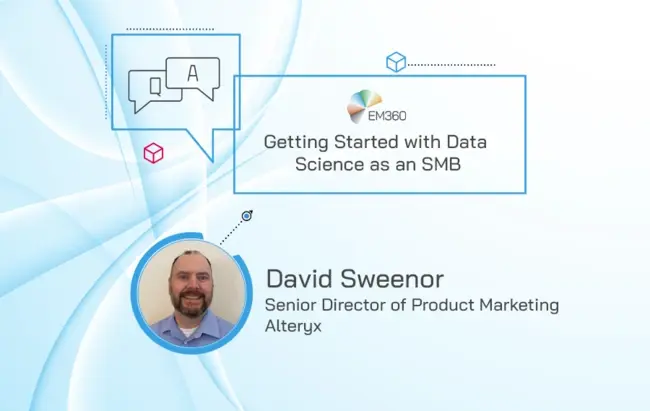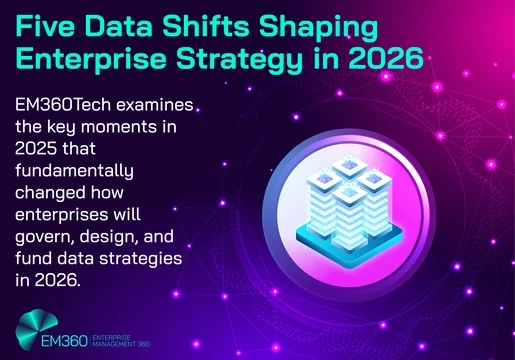Many small-midsize business (SMB) owners hold the presumption that harnessing data science is out of their reach because they can’t afford to hire an expensive data analyst. In fact, Michael Guta reports that 67% of small businesses spend more than $10,000 per year on analytics. However, analysing data doesn’t have to come with a high cost and you don’t have to be an online titan like Amazon to be able to compete in the data-driven business movement. Modern technology means that the ability to take data and turn it into a problem-solving insight is no longer exclusively within the realms of those companies with big budgets or individuals with years of experience or a specific university degree. These myths against the use of data in SMBs need to be dispelled. It's time for SMBs to leverage data in order to survive and thrive!
Joining us in this week’s Q&A to share his expertise on how SMBs can get started on their data science journey and obtain powerful insights from it is David Sweenor, SD of Product Marketing at Alteryx - a global leader in analytic process automation (APA). David is an analytics thought leader. He has over 20 years of hands-on business analytics experience spanning product marketing, strategy, and development, in which he specialises in data science and business intelligence.

Going back to the basics, how can SMBs benefit from utilising data science today?
In its most basic form, using data properly is a game-changer. Almost every business has this data – it may be hidden in spreadsheets or even saved locally on the computer of one worker from a time before online shared folders were fully implemented. Sometimes, I see people getting lost in the data science buzzwords – artificial intelligence, deep learning, neural networks and the like. But businesses can realise huge benefits from data science – the process by which we begin to understand data – by using clean and timely information to make quick and informed decisions.
I think that SMBs can often get stuck on the technical side of data science. They need to look beyond the technology, and instead focus on the core principles of data strategy: Projects don’t need to be expensive, nor do they need to only solve multi-million-pound problems. In the very early stages – before high value, game-changing problems have been identified – data analysis can even be done with spreadsheets.
The core benefit of using data well, in my opinion, is the ability to make informed decisions based on quantifiable, verifiable information. It’s about moving beyond the ‘lead from the top’ type mentality that’s been so prevalent in businesses over the last few decades. Effectively using data means that the person closest to a problem is actually able to have a direct input into solving said problem. This brings with it a motivation to learn, and a motivation to change. Two hugely important attributes.
On your LinkedIn profile, you write that ‘I was working with big data before it had a name’. How has the enterprise analytical data landscape evolved over your 20-year span in the industry?
When the data scientist specialism surfaced back in 2001, the biggest challenge was how to leverage insights from relatively limited data sources. Initially, there was no specific training to prepare people for the daily tasks of a data scientist – it was all database specialists, mathematicians, statisticians, and physicists often writing code from scratch. In fact, I remember writing Fortran code to analyse data (yes, I’m dating myself).
Back in 2012, Davenport and Patil declared that ‘Data Scientist’ was the “Sexiest Job of the 21st Century”. The first thing everyone did after reading that was to change their LinkedIn Profile to say they were Data Scientists for an instant salary increase.
New, simpler coding languages were later developed, and we started to see drag and drop GUIs that opened up data science to non-coders, but these were still a bit clunky.
Back then, what we would now call a ‘big data project’ was pieced together from data stored in different departments, within hard to access data silos, and controlled by different people. These data projects needed a huge number of tools and products to take the data from its base form into something useful to the business. We had to talk to the database specialists (DBAs) for access to the data, learn to write SQL, or find an expert to extract data… then we had to prepare it for analytics. Over the years, this process has become far more streamlined.
After we analysed the data, we then had to convince our management team, then we had to implement it. I distinctly remember a senior-level manager saying, “I don’t understand what PCA (Principle Component Analysis) is and I don’t trust it, we’re going with our gut.”
This kind of work needed an exceptionally high level of technological expertise and extensive coordination across a big cast of characters to generate any real added value from these complex applications, but value was created. As these early-stage data workers set the foundation of data science, the model was proven, and demand for their expertise increased.
What are the need-to-know strategies for developing an analytical data-driven culture and business?
Developing a data-driven culture requires readiness and a strong foundation, from the CEO or business owner down. The leadership team need to be all-in on analytics as standard practice – ready to support and drive the change. This is what we see in the most analytically mature companies, and it’s something that can be replicated for SMBs.
To become data-driven, we need to start with data literacy programs. To turn that data literacy into a culture, we need to look at baking in analytics in day-to-day work. This may take considerable investment but will achieve long-term payoff. To make this a reality, new initiatives are needed outside of the normal lunch and learns, from providing additional paid learner days to the gamification of learning, and career led learning for end-to-end workforce planning.
Those closest to a process know where the problems exist, and by amplifying human intelligence to get the best from data science and analytics, they have the context and can see the business impact of solving that question through data. There’s huge benefit to be found here.
Do you think that all employees should be equipped with data analytics, no matter their experience or background?
There’s an important distinction that needs to be made here between ‘can’ and ‘should’. With modern technology and systems becoming more and more approachable and user-friendly, anyone can become a citizen data scientist – a person who is able to use data analytics to create insights. Whether employees should be equipped with these tools is a question that can only be answered at a micro-level by individual businesses. Different use cases require different approaches and levels of governance.
There is a limited benefit that could be generated by upskilling store cashiers with data analytics skillsets, for example, but equipping other back-office workers or store managers with data analytics skills could certainly drive value. One option is using computer vision to automate the extraction of data from clock-in cards for timesheet purposes or even automating the extraction of text from receipts and supply-chain invoices.
Ultimately, while the option of using data analytics is an option for everyone, businesses looking to upskill their workers still have to follow a core cost-benefit model.
How can organisations identify the right problems to solve and set themselves up for success with analytical data?
Finding the right problem to solve is a challenge that’s unique to each individual business. There are certainly some common threads which can be followed, and the problems themselves can be an amalgam of people, processes, legacy technologies, or even geographic location.
Before embarking on a data analytics journey, in my experience, organisations will always have some idea as to what their ideal problem to solve is. The key to being successful is to understand the business decision to be made – and work backwards from there. I call it starting small, and scaling big.
Finding the right problem is often the end result of numerous smaller-scale wins as organisations begin to understand not only what they actually need, but also what resources and tools they have in order to get there. It’s about the process – actually completing and fixing small irritations, cutting away at the unnecessary, and using these projects as building blocks to get to where you need to go.
In what ways are advanced analytics platforms like Alteryx helping SMBs to keep up with the data-driven business movement and compete with online giants who have analytical data at their fingertips? Please share a case study example if you have one.
The ability to integrate new data points into an analytic process to deliver real-time insights – and the ability to rapidly adapt to changing market demands - is what separates digital-native businesses such as Netflix and Amazon from more legacy organisations buried in technical debt. The true value of successful analytics work, however, comes from automating these insights – freeing up the project leader to focus on newer and higher-value projects in tandem. The actual adopters of these insights know the business process they relate to and therefore including them is essential to the design and rollout of such projects.
By investing in non-technical tools such as self-service platforms that every employee - from the marketing department to business operations - can easily use, workers are given the space to experiment and learn new data skills at their own pace. These platforms can support workers as they discover how to automate analytic processes to unlock powerful insights from data, creating a strong skills foundation for the future.
Automating how you discover, analyse, and reach answers is enabling companies to get ahead of their competition. But what’s paramount is that everyone in the workforce should be able to do it, not just a handful of specialists. That’s where ease-of-use and self-service automation comes in. Thousands of organizations and citizen analysts - from small companies to the Global 2000 - rely on our analytics and data science automation every day to find ground-breaking answers to almost any business question.
Liked this article? Subscribe to the YouTube Channel for more educational content in enterprise technology.







Comments ( 0 )